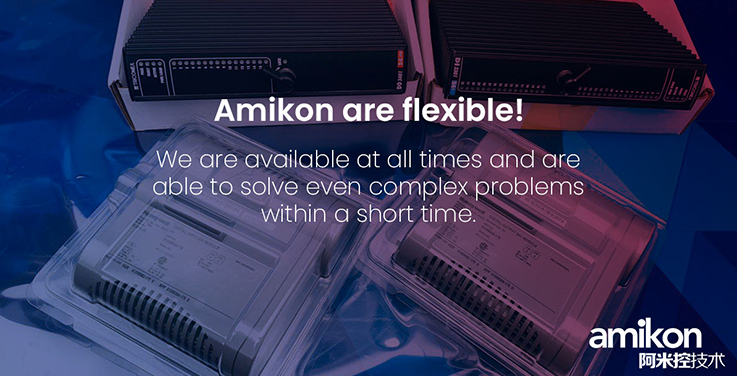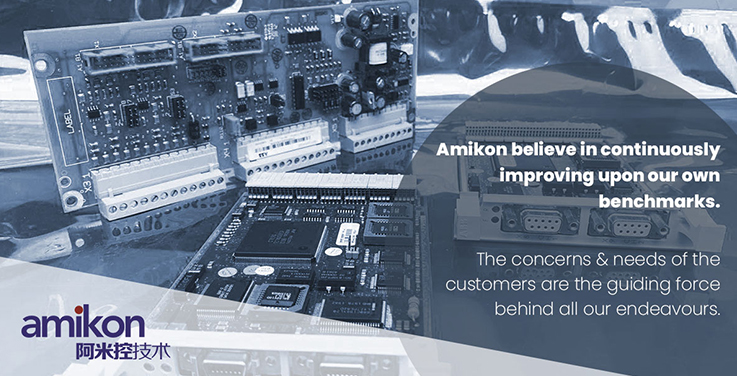-
Manufacturers
- ABB Advant OCS and Advant-800xA
- ABB Bailey
- ABB Drives
- ABB H&B Contronic
- ABB H&B Freelance 2000
- ABB Master
- ABB MOD 300 and MOD 30ML/MODCELL
- ABB Procontic
- ABB Procontrol
- ABB Synpol D
- Allen-Bradley SLC 500
- Allen-Bradley PLC-5
- Allen-Bradley ControlLogix
- Allen-Bradley CompactLogix
- Allen-Bradley MicroLogix
- Allen-Bradley PanelView
- Allen-Bradley Kinetix Servo Drive
- Allen-Bradley PowerFlex
- Allen-Bradley Smart Speed Controllers
- 21500 TDXnet Transient
- 3300 System
- 3500 System
- 990 and 991 Transmitter
- 31000 and 32000 Proximity Probe Housing Assemblie
- 21000, 24701, and 164818 ProbeHousing Assemblies
- 177230 Seismic Transmitter
- TK-3 Proximity System
- 330500 and 330525 Piezo-Velocity Sensor
- 7200 Proximity Transducer Systems
- GE 90-70 Series PLC
- GE PACSystems RX7i
- GE PACSystems RX3i
- GE QuickPanel
- GE VersaMax
- GE Genius I/O
- GE Mark VIe
- GE Series One
- GE Multilin
- 800 Series I/O
- Modicon 984
- Modicon Premium
- Modicon Micro
- Modicon Quantum
- Telemecanique TSX Compact
- Altivar Process
- Categories
- Service
- News
- Contact us
-
Please try to be as accurate as possible with your search.
-
We can quote you on 1000s of specialist parts, even if they are not listed on our website.
-
We can't find any results for “”.
How to choose the right AC drive
How to choose the right AC drive
Having more choices is not always a good thing. Take AC frequency converter as an example: In the past, only a few companies produced AC frequency converters, and they were mainly used for basic motor speed control. There are hundreds of brands, multiple types, and a wealth of communication and control options, all of which may confuse you.
Know your motor
Checking the nameplate on the motor is the first step in specifying the correct inverter drive. Most AC motors have a nameplate that will indicate the power supply voltage, kilowatts or power, and amperage. To convert horsepower to kilowatts, simply multiply horsepower by 0.75. Make a note of this information, as it is very important to specify the correct drive. Note that you will need a DC drive for DC motors.
There may be a lot of information on the motor nameplate, so if you are not sure what you are looking for, please take a picture of the nameplate and email it to us.
Understand your requirements

Consider the environment
Take a moment to consider where the variable speed drive is installed. If the environment is corrosive or very humid, then the wise choice is to install the inverter driver in the panel or buy a driver with a higher IP rating. IP stands for Ingress Protection, usually a two-digit number. The higher the level, the higher the protection. Variable speed drives affected by flushing procedures or extreme conditions must be sealed to at least IP65 or IP67.
Control your drive
Consider how to control the speed of the inverter. Do you plan to use the keyboard, potentiometer or PLC to control the speed of the AC drive? If the variable speed drive is not easily accessible (ie, inside the panel), you may want to consider using a remote keyboard or PLC.
Determine your inverter I/O requirements
Your new inverter drive will need to interact with other equipment in the factory. Therefore, it is important to know how many inputs and outputs and the types of inputs and outputs you will need.
The digital input is used to connect the inverter drive with PLC, switches, buttons and other equipment. These signals can be used for start/stop, forward/reverse, external fault, preset speed selection and other functions.
On the other hand, the analog input allows the driver to be controlled by a simple 0-10VDC or 4-20 mA signal. This can be as simple as a jar, or it can be feedback from a PID controller.
The PTK input can be used to monitor simple temperature sensors in the motor windings to avoid damage under overload conditions.
Digital and relay outputs are useful when you want to notify the external device of the status of the external device, for example, if a fault occurs or the set speed is reached.
Communication requirements
Profibus, Modbus, Ethernet, CanBus...the list of available communication options is endless. Fortunately, most modern frequency converter drives (such as Yaskawa A1000 and Control Techniques Unidrive SP) have plug-in expansion modules that can access most communication protocols.
Programming
Programming a VSD can be a daunting task. Unfortunately, too many manufacturers focus on high-end applications and make simple application programming much more difficult than originally needed. It is estimated that 60% of operators use only the first 7 parameters. For simple applications, we recommend the Control Techniques M200 or Danfoss Micro Drive series, which are very easy to set up and have pre-loaded parameters for standard tasks. For more complex tasks, we recommend using Control Techniques M700 or Danfoss VLT AutomationDrive, which are also easy to install, but provide more functions than simple M200 and Micro Drive AC drives.

All variable speed drives need a filter to avoid transmitting electrical noise back to the power supply. Some frequency converter drives come standard with integrated industrial filters, while other frequency converters have no internal filters at all. Which method is more suitable for you depends on how the drive is installed. For example, if you install multiple drives in one panel, a drive without a filter can save costs because you can use one filter to provide all drives. If you want to install the drive in a residential or commercial environment, such as an escalator in a shopping mall, you need a commercial filter.
Keep your system in play!

Related articles Browse All
-
 amikong NewsSchneider Electric HMIGTO5310: A Powerful Touchscreen Panel for Industrial Automation2025-08-11 16:24:25Overview of the Schneider Electric HMIGTO5310 The Schneider Electric HMIGTO5310 is a high-performance Magelis GTO touchscreen panel designed for industrial automation and infrastructure applications. With a 10.4" TFT LCD display and 640 x 480 VGA resolution, this HMI delivers crisp, clear visu...
amikong NewsSchneider Electric HMIGTO5310: A Powerful Touchscreen Panel for Industrial Automation2025-08-11 16:24:25Overview of the Schneider Electric HMIGTO5310 The Schneider Electric HMIGTO5310 is a high-performance Magelis GTO touchscreen panel designed for industrial automation and infrastructure applications. With a 10.4" TFT LCD display and 640 x 480 VGA resolution, this HMI delivers crisp, clear visu... -
 BlogImplementing Vision Systems for Industrial Robots: Enhancing Precision and Automation2025-08-12 11:26:54Industrial robots gain powerful new abilities through vision systems. These systems give robots the sense of sight, so they can understand and react to what is around them. So, robots can perform complex tasks with greater accuracy and flexibility. Automation in manufacturing reaches a new level of ...
BlogImplementing Vision Systems for Industrial Robots: Enhancing Precision and Automation2025-08-12 11:26:54Industrial robots gain powerful new abilities through vision systems. These systems give robots the sense of sight, so they can understand and react to what is around them. So, robots can perform complex tasks with greater accuracy and flexibility. Automation in manufacturing reaches a new level of ... -
 BlogOptimizing PM Schedules Data-Driven Approaches to Preventative Maintenance2025-08-21 18:08:33Moving away from fixed maintenance schedules is a significant operational shift. Companies now use data to guide their maintenance efforts. This change leads to greater efficiency and equipment reliability. The goal is to perform the right task at the right time, based on real information, not just ...
BlogOptimizing PM Schedules Data-Driven Approaches to Preventative Maintenance2025-08-21 18:08:33Moving away from fixed maintenance schedules is a significant operational shift. Companies now use data to guide their maintenance efforts. This change leads to greater efficiency and equipment reliability. The goal is to perform the right task at the right time, based on real information, not just ...

Need an automation or control part quickly?
- About us
- Our Team Contact Us 20 Years in Business About us
- Q&A
- Policies How to order Part status information Shiping method Return Policy Warranty Policy payment terms
- Asset Recovery
- We Buy Your Equipment. Industry Cases
- ADDRESS
-
 32D UNITS,GUOMAO BUILDING,NO 388 HUBIN SOUTH ROAD,SIMING DISTRICT,XIAMEN
32D UNITS,GUOMAO BUILDING,NO 388 HUBIN SOUTH ROAD,SIMING DISTRICT,XIAMEN
Copyright Notice © 2004-2024 amikong.com All rights reserved
Disclaimer: We are not an authorized distributor or distributor of the product manufacturer of this website, The product may have older date codes or be an older series than that available direct from the factory or authorized dealers. Because our company is not an authorized distributor of this product, the Original Manufacturer’s warranty does not apply.While many DCS PLC products will have firmware already installed, Our company makes no representation as to whether a DSC PLC product will or will not have firmware and, if it does have firmware, whether the firmware is the revision level that you need for your application. Our company also makes no representations as to your ability or right to download or otherwise obtain firmware for the product from our company, its distributors, or any other source. Our company also makes no representations as to your right to install any such firmware on the product. Our company will not obtain or supply firmware on your behalf. It is your obligation to comply with the terms of any End-User License Agreement or similar document related to obtaining or installing firmware.



